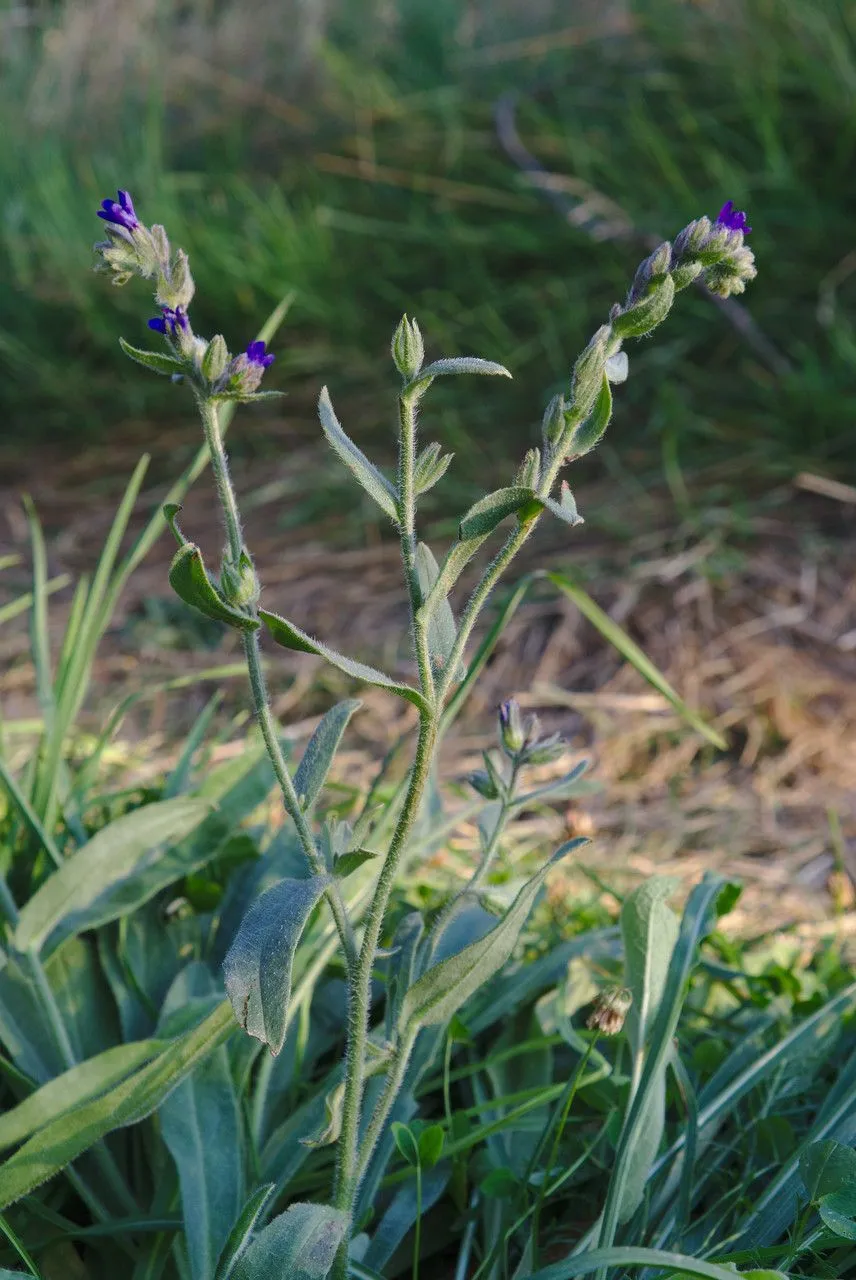
Author: L.
Bibliography: Sp. Pl.: 133 (1753)
Year: 1753
Status: accepted
Rank: species
Genus: Anchusa
Vegetable: False
Observations: Europe to Caucasus
Alkanet, scientifically recognized as Anchusa officinalis, is a remarkable herbaceous plant that belongs to the family Boraginaceae. Originating from a geographic range that extends from Europe to the Caucasus, this plant carries a rich legacy in both botanical and traditional contexts.
One of the plant’s most striking features is its vibrant blue flowers, which bloom profusely from late spring to mid-summer. Each individual flower is a beautiful testament to nature’s intricate design, with a tubular shape that often attracts bees and other pollinators. This graceful interaction with pollinators highlights the essential role Anchusa officinalis plays in supporting local ecosystems.
The foliage of the Alkanet is equally noteworthy. The leaves are slender, somewhat lance-shaped, and covered in fine bristles, which add a unique texture to the plant. This characteristic is typical of many members of the Boraginaceae family. The overall plant can reach heights of up to 60-80 cm, making it an attractive addition to backyards and garden landscapes.
Historically, Anchusa officinalis has been utilized for its medicinal properties. Traditional herbalists have employed parts of the plant in treatments for respiratory and skin ailments. While modern scientific validation is limited, this historical usage underscores the plant’s significant role in folk medicine across its native range.
Alkanet is relatively easy to grow and is favored by gardeners who appreciate its resilience and ease of care. It thrives in well-drained soil and can tolerate a range of sunlight conditions, although it often performs best in full to partial sun. Due to its adaptability, it can be found flourishing in a variety of environments, from roadsides to cultivated gardens.
The plant’s inclusion in ‘Sp. Pl.: 133 (1753)’ by the authoritative botanist L. symbolizes its importance and recognition in the botanical community. This documented acknowledgment places Alkanet among the well-studied and classified species, signifying its status within the realm of plant science.
In essence, Anchusa officinalis, or Alkanet, is a plant of both aesthetic appeal and historical significance. Its vivid blue blooms, coupled with its traditional uses and ease of cultivation, make it a cherished species within its native habitats and in gardens worldwide.
Eng: alkanet, common bugloss, bugloss, oxtongue, true alkanet, common alkanet
Fra: buglosse officinale
Swe: daggros, japansk klätterros, pimpinellros, vresros, oxtunga, rohtorasti, vanlig oxtunga
Nor: doggrose, rynkeros, småklatrerose, trollnype, oxetunge
Deu: echte ochsenzunge, gemeine ochsenzunge, gewöhnliche ochsenzunge
Fin: juhannusruusu, kurttulehtiruusu, punalehtiruusu, rohtorasti
Dan: klit-rose, kobber-rose, læge-oksetunge, mangeblomstret rose, rynket rose
Spa: buglosa
Nld: gewone ossentong
Nno: oksetunge
Nob: oksetunge
Ces: pilát lékařský
Sme: vuovssánjuovčča
Cym: alcanet, llysiau’r-gwrid
En: Alkanet, Common bugloss, Oxtongue, Bugloss, Kōanahi onanikian, True Alkanet, Common alkanet, True Bugloss
Ar: لسان الثور المخزني
Az: Anchusa officinale, Dərman sümürgəni
Be: Пакрывец лекавы
Bg: Лечебно винче
Zh: 药用牛舌草, 药用牛舍草
Hr: Runjava trava
Cs: Pilát lékařský
Da: Anchusa officialis, Læge-Oksetunge, Klit-Rose, Kobber-Rose, Mangeblomstret Rose, Rynket Rose
Nl: Gewone ossentong, Gewone ossetong
Et: Imikas
Fi: Rohtorasti, Häränkieli, Juhannusruusu, Kurttulehtiruusu, Punalehtiruusu
Fr: Buglosse officinale
De: Gemeine Ochsenzunge, Gewöhnliche Ochsenzunge, Gebräuchliche Ochsenzunge, Echte Ochsenzunge
Hu: Orvosi atracél
It: Buglossa comune
Lt: Paprastasis godas, Vaistinis godas
Se: Vuovssánjuovčča
No: Oksetunge, Doggrose, Rynkeros, Småklatrerose, Trollnype, Oxetunge
Nb: Oksetunge
Nn: Oksetunge
Os: Урусудз
Pl: Farbownik lekarski
Pt-br: Buglossa
Ru: Анхуза лекарственная, Воловик лекарственный
Sk: Smohla lekárska
Es: Buglosa, Argamala, Argámula, Buglosa oficinal, Buglosa vulgar, Chupa-mieles, Lengua de buey salvaje, Lengua de buey, Lengua de culebra, Lengua de vaca, Lenguaza, Melera, Miel de avispas, Navadni volovski jezik, Raiz de fuego
Sv: Oxtunga, Fåretunga, Daggros, Japansk klätterros, Pimpinellros, Vresros, Rohtorasti, Vanlig oxtunga
Zh-tw: 藥用牛舌草
Tt: Шифалы үгез теле
Zh-hant: 藥用牛舌草
Tr: Adi sığırdili
Uk: Воловик лікарський
Cy: Llysiau’r-gwrid, Alcanet
© copyright of the Board of Trustees of the Royal Botanic Gardens, Kew.
© copyright of the Board of Trustees of the Royal Botanic Gardens, Kew.
© copyright of the Board of Trustees of the Royal Botanic Gardens, Kew.
Taken Jun 24, 2021 by nicolas pecqueux (cc-by-sa)
Taken Aug 8, 2019 by Stefan Kamps (cc-by-sa)
Taken Jun 19, 2016 by Henk Van Lottum (cc-by-sa)
Taken Jul 2, 2017 by Erim Kocyigit (cc-by-sa)
Taken Jul 2, 2019 by Marianne Eijgendaal (cc-by-sa)
Taken Jul 17, 2021 by A Poirel (cc-by-sa)
Taken Nov 12, 2022 by Kai Best (cc-by-sa)
Taken Jun 19, 2016 by Henk Van Lottum (cc-by-sa)
Taken Aug 8, 2019 by Stefan Kamps (cc-by-sa)
Taken Dec 8, 2002 by Angie Ang (cc-by-sa)
Taken Jan 1, 2019 by José Ayuste (cc-by-sa)
Taken Jul 27, 2021 by filipik marta (cc-by-sa)
Taken Nov 12, 2022 by Kai Best (cc-by-sa)
Taken Jul 17, 2021 by A Poirel (cc-by-sa)
Taken Aug 8, 2019 by Stefan Kamps (cc-by-sa)
Taken May 4, 2022 by Marie-Pia Marchant (cc-by-sa)
Taken Jun 22, 2021 by Joanna Wrońska (cc-by-sa)
Taken Jun 26, 2021 by Sabin Poenariu (cc-by-sa)
Taken May 12, 2022 by sonicor (cc-by-sa)
Taken Jan 1, 1800 by Tela Botanica − Thierry Pernot (cc-by-sa)
Taken Apr 10, 2021 by Poza Laura (cc-by-sa)
Taken Jun 5, 2020 by Kunze Ute (cc-by-sa)
Taken May 18, 2022 by Anna Sokolsky (cc-by-sa)
Taken Jul 14, 2021 by Rico Mende (cc-by-sa)
Taken May 14, 2021 by ñah (cc-by-sa)
Taken Jul 18, 2020 by Schuller Ton (cc-by-sa)
Taken Sep 27, 2022 by Stefana Popova (cc-by-sa)
Taken Jun 13, 2021 by frietman (cc-by-sa)
Taken Sep 11, 2022 by bülent balkan (cc-by-sa)
Taken Jul 7, 2015 by Tela Botanica − Yoan MARTIN (cc-by-sa)
Family: Myrtaceae Author: (F.Muell.) K.D.Hill & L.A.S.Johnson Bibliography: Telopea 6: 402 (1995) Year: 1995 Status:…
Family: Rubiaceae Author: Pierre ex A.Froehner Bibliography: Notizbl. Bot. Gart. Berlin-Dahlem 1: 237 (1897) Year:…
Family: Sapindaceae Author: Koidz. Bibliography: J. Coll. Sci. Imp. Univ. Tokyo 32(1): 38 (1911) Year:…
Family: Asteraceae Author: A.Gray Bibliography: Pacif. Railr. Rep.: 107 (1857) Year: 1857 Status: accepted Rank:…
Family: Fabaceae Author: Medik. Bibliography: Vorles. Churpfälz. Phys.-Ökon. Ges. 2: 398 (1787) Year: 1787 Status:…
Family: Aspleniaceae Author: (Cav.) Alston Bibliography: Bull. Misc. Inform. Kew 1932: 309 (1932) Year: 1932…